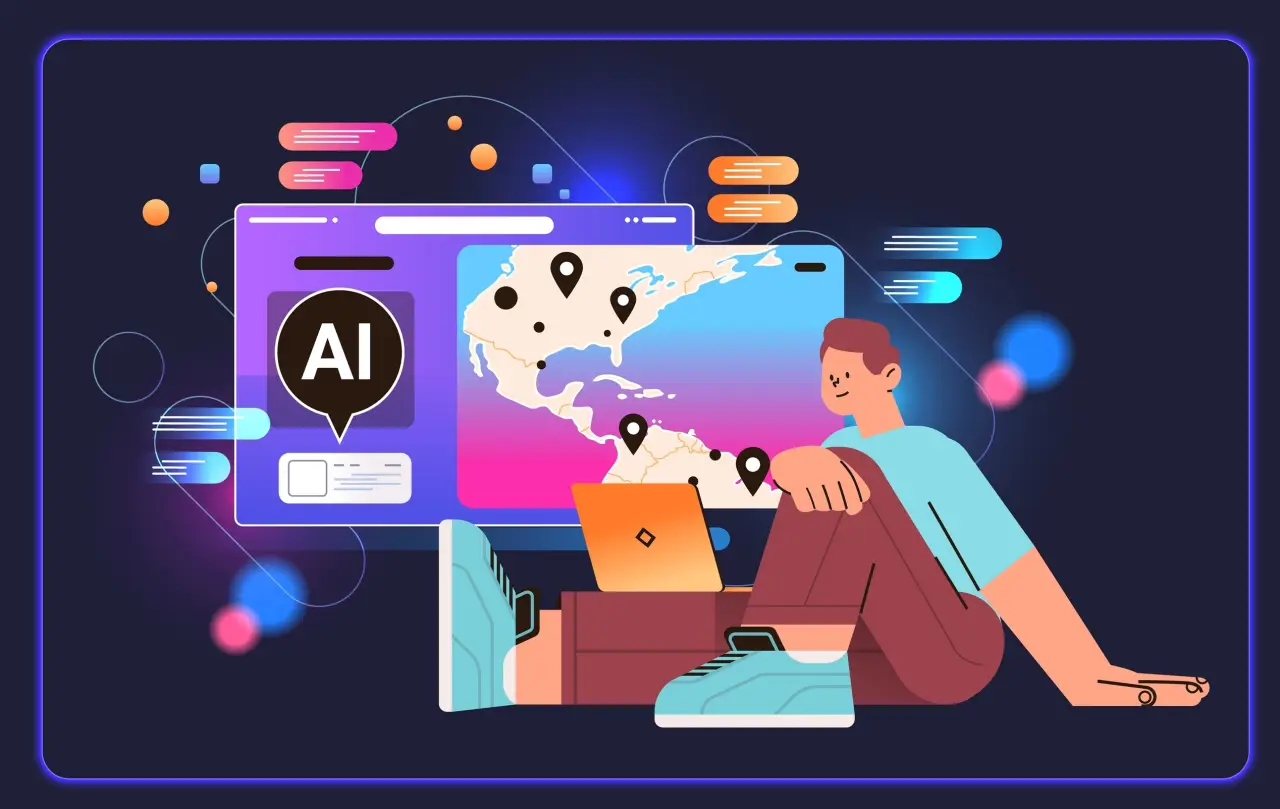AI Insights
AI isn’t having a ’90s internet moment, it’s more like ’60s personal computing, and it needs one special company to kickstart the revolution

Fresh on the heels of the announcement of President Trump’s AI Action Plan, China released a global action plan for artificial intelligence, calling for international cooperation on tech development and regulation. China’s plan, announced at the annual state-organized World Artificial Intelligence Conference, focused on how China plans to partner with the Global South to promote AI standards around the world.
It’s undeniable that AI is going to make a significant impact on our economy. But there’s always a chance AI could be another bubble. I lived through the internet expansion of the ’90s, and AI is on pace to be much bigger, more disruptive, and more impactful. AI has the potential to impact every human being and company in the world. In order to achieve this and ensure that Western values drive AI adoption, we have three big things to fix before AI can become the “new internet” that changes every interaction we have.
Accessing critical AI infrastructure is hindered by the following fundamental problems: crushing costs, extreme concentration, and insufficient capacity. The U.S. AI Action Plan framed it as, “Currently, a company seeking to use largescale compute must often sign long-term contracts with hyperscalers—far beyond the budgetary reach of most academics and many startups.” Further, data transfer fees, the costs a company faces when moving its own data out of a cloud system, strangle competition by creating artificial barriers that have nothing to do with technical merits.
Part of what made the Internet open to all was the common TCP/IP standard, that lets any computer talk to any other computer. This ability to connect outside of the (then) walled garden of AOL opened up new business uses while creativity flourished and capabilities improved rapidly.
If we want AI to grow and succeed like the Internet, we need the global standards and open exchange that can make accessing it as easy as sending a packet from one computer to the next. Beijing has already published several action plans that help provide direct subsidies to AI companies and make vast datasets available to national champions through public-private partnerships, providing common approaches for Chinese companies to follow. The Chinese government has announced a state-run exchange to catalog and market compute. For too long, America’s fragmented approach and lack of national strategy has risked ceding our current AI leadership permanently. By setting the standards that will help us stay ahead in AI, we can create the type of market-driven solutions that will quickly bring the power of American AI to more of the world’s population.
The ’40s, the ’60s, the ’90s and today
Before the internet, we can look further back to the age of the mainframe and the transition to the PC for insight. In the 1940s, computing power was so expensive that only governments could afford it, housing room-sized machines in hangars and partnering with universities for access. Today, my pocket-sized phone is more powerful than those early supercomputers. What changed? IBM led the commoditization of computer hardware while building a profitable business. Microsoft and Linux created operating system standards. These changes rolled out over decades, but today’s technology moves so much faster, and calls for a faster response to stay competitive.
Today, AI sits where computing did in the 1960s — powerful but accessible only to those with massive resources. We need our own IBM PC revolution for artificial intelligence, with open standards and exchange, so we can move as quickly as possible to win the global war for AI.
This shift won’t happen just through government mandate, nor should it. It requires market forces guided by open standards that make AI resources truly accessible and interoperable. When companies can easily compare compute options and move workloads between providers, competition will drive market-efficient prices and improve service. When developers can access standardized AI infrastructure without months of advance planning, innovation accelerates.
This approach serves America’s strategic interests. When our allies and our adversaries can easily adopt US-developed AI standards and infrastructure, we strengthen the entire democratic technology ecosystem. President Trump’s move to allow China to purchase NVIDIA H20 processors helps us in the long-term, because it helps encourage Chinese developers to build on American technology. When adversaries rely on an American technology stack, we gain influence far beyond what export controls can achieve while promoting our democratic values.
The government has a role here to ensure markets function competitively. Strategic compute reserves could provide emergency capacity during crises, similar to our strategic oil reserve. Procurement policies can prioritize small and medium enterprises over concentrated providers, especially government procurement. Standards development can prevent the kind of fragmentation that has historically hampered American technology leadership.
This is the time for swift action.
President Trump has promised to keep America “the hottest country” in technology and his AI Action Plan positions us for success. China has a plan that they’ve been working on for years. Delivering on the promise of AI for the Western world requires not only a government commitment to leadership but also creating the market conditions where American innovation can flourish – open, competitive, and accessible to everyone willing to build the future.
The opinions expressed in Fortune.com commentary pieces are solely the views of their authors and do not necessarily reflect the opinions and beliefs of Fortune.
AI Insights
Here’s what parents need to know about artificial intelligence

ChatGPT, AI chatbots, and the growing world of artificial intelligence: it’s another conversation parents may not have planned on having with their kids.
A new Harvard study found that half of all young adults have already used AI, and younger kids are quickly joining in.
Karl Ernsberger, a former high school teacher turned AI entrepreneur, says that’s not necessarily a bad thing.
“It is here to stay. It’s like people trying to resist the Industrial Revolution,” Ernsberger said.
Ernsberger believes tools like chatbots can be powerful for learning, but only if kids and parents know the limits.
One example is “Rudi the Red Panda,” a virtual character available for free in kids mode on X’s Grok AI. When asked, Rudi can even answer questions about Arizona history.
GROK
“The five C’s of Arizona are Copper, Cotton, Cattle, Citrus, Climate,” Rudi said.
But Ernsberger warns that children may struggle to understand that Rudi isn’t real, and that “friendship” with a chatbot is different from human connection.
“It’s hard for the student to actually develop a real friendship,” he said. “They get confused by that because friendship is something they continue to learn about as they get older.”
When asked if Rudi was really my best friend, it replied: “I’m as real as a red panda can be in your imagination. I’m here to be your best friend.”
That, Ernsberger says, is where parents need to step in.
For families trying to keep kids safe while exploring AI, Ernsberger’s first recommendation is simple.
“Use it yourself. There are so many use cases, so many different things that can be done with AI. Just finding a familiarity with it can help you find the weaknesses for your case, and its weaknesses for your kids.”
Then he says if your child is using AI, be there with them to watch over and keep the human connection.
“The key thing with AI is it’s challenging our ability to connect with each other, that’s a different kind of challenge to society than any other tool we’ve built in the past,” Ernsberger said.
Regulators are paying attention, too.
Arizona Attorney General Kris Mayes, along with 43 other state attorneys general, recently sent a letter to 12 AI companies, including the maker of Rudi, demanding stronger safeguards to protect young users.
AI Insights
This MOSI exhibit will give you a hands-on look at artificial intelligence – Tampa Bay Times
AI Insights
Spain Leads Europe in Adopting AI for Vacation Planning, Study Shows

Spain records higher adoption of Artificial Intelligence – AI in vacation planning than the European average, according to the 2025 Europ Assistance-Ipsos barometer.
The study finds that 20% of Spanish travelers have used AI-based tools to organize or book their holidays, compared with 16% across Europe.
The research highlights Spain as one of the leading countries in integrating digital tools into travel planning. AI applications are most commonly used for accommodation searches, destination information, and itinerary planning, indicating a shift in how tourists prepare for trips.
Growing Use of AI in Travel
According to the survey, 48% of Spanish travelers using AI rely on it for accommodation recommendations, while 47% use it for information about destinations. Another 37% turn to AI tools for help creating itineraries. The technology is also used for finding activities (33%) and booking platform recommendations (26%).
Looking ahead, the interest in AI continues to grow. The report shows that 26% of Spanish respondents plan to use AI in future travel planning, compared with 21% of Europeans overall. However, 39% of Spanish participants remain undecided about whether they will adopt such tools.
Comparison with European Trends
The survey indicates that Spanish travelers are more proactive than the European average in experimenting with AI for holidays. While adoption is not yet universal, Spain’s figures consistently exceed continental averages, underscoring the country’s readiness to embrace new technologies in tourism.
In Europe as a whole, AI is beginning to make inroads into vacation planning but at a slower pace. The 2025 Europ Assistance-Ipsos barometer suggests that cultural attitudes and awareness of technological solutions may play a role in shaping adoption levels across different countries.
Changing Travel Behaviors
The findings suggest a gradual transformation in how trips are organized. Traditional methods such as guidebooks and personal recommendations are being complemented—and in some cases replaced—by AI-driven suggestions. From streamlining searches for accommodation to tailoring activity options, digital tools are expanding their influence on the traveler experience.
While Spain shows higher-than-average adoption rates, the survey also reflects caution. A significant portion of travelers remain unsure about whether they will use AI in the future, highlighting that trust, familiarity, and data privacy considerations continue to influence behavior.
The Europ Assistance-Ipsos barometer confirms that Spain is emerging as a frontrunner in adopting AI for travel planning, reflecting both a strong appetite for digital solutions and an evolving approach to how holidays are designed and booked.
Photo Credit: ProStockStudio / Shutterstock.com
-
Tools & Platforms3 weeks ago
Building Trust in Military AI Starts with Opening the Black Box – War on the Rocks
-

 Business2 days ago
Business2 days agoThe Guardian view on Trump and the Fed: independence is no substitute for accountability | Editorial
-

 Ethics & Policy1 month ago
Ethics & Policy1 month agoSDAIA Supports Saudi Arabia’s Leadership in Shaping Global AI Ethics, Policy, and Research – وكالة الأنباء السعودية
-

 Events & Conferences3 months ago
Events & Conferences3 months agoJourney to 1000 models: Scaling Instagram’s recommendation system
-

 Jobs & Careers2 months ago
Jobs & Careers2 months agoMumbai-based Perplexity Alternative Has 60k+ Users Without Funding
-

 Funding & Business2 months ago
Funding & Business2 months agoKayak and Expedia race to build AI travel agents that turn social posts into itineraries
-

 Education2 months ago
Education2 months agoVEX Robotics launches AI-powered classroom robotics system
-

 Podcasts & Talks2 months ago
Podcasts & Talks2 months agoHappy 4th of July! 🎆 Made with Veo 3 in Gemini
-

 Podcasts & Talks2 months ago
Podcasts & Talks2 months agoOpenAI 🤝 @teamganassi
-

 Mergers & Acquisitions2 months ago
Mergers & Acquisitions2 months agoDonald Trump suggests US government review subsidies to Elon Musk’s companies






















